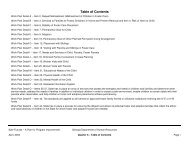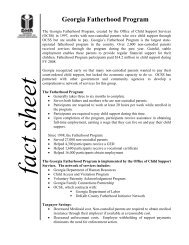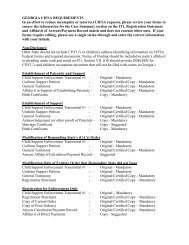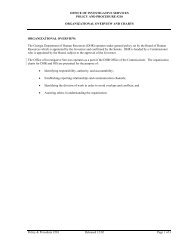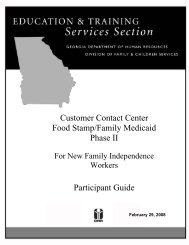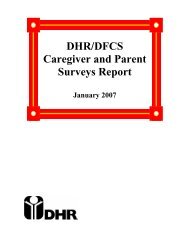an overview georgia program improvement plan - Department of ...
an overview georgia program improvement plan - Department of ...
an overview georgia program improvement plan - Department of ...
Create successful ePaper yourself
Turn your PDF publications into a flip-book with our unique Google optimized e-Paper software.
5 th Quarter DOCUMENTATION:<br />
PIP Results 02/18/2004 From CPRS… Perm<strong>an</strong>ency Goal for Children<br />
6 th Quarter Report: The last CPRS quarterly report “Perm<strong>an</strong>ency Goal for Children” was run in February 2004. It is too early to<br />
report <strong>an</strong>other quarter. The next CPRS report will be reflected in the next PIP reporting period.<br />
6 th Quarter Federal Response: D4: The State is requesting <strong>an</strong>other modification -- to ch<strong>an</strong>ge the Benchmark from 'Every child<br />
coming into care will have a case pl<strong>an</strong> in CPRS' to 'Perm<strong>an</strong>ency goals will be documented in 90% <strong>of</strong> the case pl<strong>an</strong>s.' The State has<br />
previously reported that the perm<strong>an</strong>ency goal is a 'required field' in CPRS. If that is the case, then perm<strong>an</strong>ency goals would, by virtue<br />
<strong>of</strong> the requirement, be documented in 100% <strong>of</strong> the case pl<strong>an</strong>s. The original benchmark has more me<strong>an</strong>ing for Item 7 th<strong>an</strong> the requested<br />
ch<strong>an</strong>ge.<br />
7 TH Quarter Report: The intent <strong>of</strong> the request to ch<strong>an</strong>ge the benchmark was to qu<strong>an</strong>tify the measurement as it relates to the<br />
evaluation statement in the Action Step. However, in complying with ACF 6 th Report comments, the State will provide information<br />
on the number <strong>of</strong> children having case pl<strong>an</strong>s in CPRS. There are 20,730 case pl<strong>an</strong>s in CPRS. The AFCARS Data Frequency Report<br />
for October 1, 2003 through March 31, 2004 reports a total number <strong>of</strong> 19,426 children in foster care for that time period, with 14, 410<br />
children remaining in foster care on March 31, 2004. The number <strong>of</strong> pl<strong>an</strong>s in CPRS is higher due to several factors. During the<br />
migration <strong>of</strong> pl<strong>an</strong>s from the original CPRS to CPRSv2, duplicate cases were created. The counties were not aware that they needed to<br />
close the original pl<strong>an</strong>, so the duplicate pl<strong>an</strong>s remain. Other pl<strong>an</strong>s should have been closed when their case was closed. The Division<br />
is now providing training to supervisors on how to identify pl<strong>an</strong>s that need to be closed <strong>an</strong>d how to close them. Additionally,<br />
supervisors <strong>an</strong>d workers are receiving training on how to create a new pl<strong>an</strong> <strong>an</strong>d review existing pl<strong>an</strong>s. The developer for the system<br />
will review the system for “junk pl<strong>an</strong>s” <strong>an</strong>d delete as appropriate. Even without the duplication, it will be difficult to have two<br />
different data systems to exactly match. However, the State is striving to get as close as possible to<br />
7 TH Quarter DOCUMENTATION: CPRS Case Pl<strong>an</strong> Report by Pl<strong>an</strong> Types<br />
8 th Quarter Report: Achieved. Per ACF request 7 th quarter regarding CPRS Case Pl<strong>an</strong> Data Cle<strong>an</strong> up: On October 22, State DFCS<br />
received the list <strong>of</strong> cases in CPRS that do not match <strong>an</strong> open case in IDS. After reviewing the list, the project administrator was able<br />
to determine several causes for the unmatched cases, which include: 1. Child's name is entered one way in CPRS <strong>an</strong>d a different way<br />
in IDS. 2. Case number is either missing from CPRS or is a different format from IDS. 2. Cases where there is more th<strong>an</strong> one draft<br />
pl<strong>an</strong> for each child, because the worker had a problem <strong>an</strong>d started over without completing the first pl<strong>an</strong>. 3. Cases where there is<br />
more th<strong>an</strong> one draft pl<strong>an</strong> for each child, because the worker was not aware that they should use the original pl<strong>an</strong> to edit for a case<br />
review. 4. Cases where all children have exited care <strong>an</strong>d there are no aftercare services being provided. 5. Cases where the worker<br />
created a pl<strong>an</strong> group for the father <strong>an</strong>d a pl<strong>an</strong> group for the mother. The case pl<strong>an</strong> is the child's pl<strong>an</strong>, <strong>an</strong>d there should be one pl<strong>an</strong>. 6.<br />
Safe Futures – A Pl<strong>an</strong> for Program Improvement<br />
Georgia <strong>Department</strong> <strong>of</strong> Hum<strong>an</strong> Resources<br />
November, 2004 Quarter 8 - Work Pl<strong>an</strong> D Page 6




